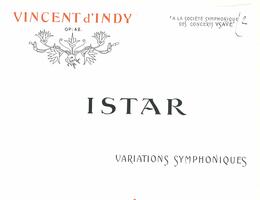Istar op. 42

Symphonic variations, first performed on 10 January 1897 in Brussels.
While exotic lands fired the imagination of many French composers at the turn of the twentieth century, Vincent d’Indy showed little interest in orientalism. However, in 1896 he composed Istar, “symphonic variations”, first performed on 10 January 1897 in Brussels, with Eugène Ysaÿe (its dedicatee) conducting. A few years earlier, the heroine of the ancient Assyrian epic of Izdubar (Gilgamesh) had inspired Joséphin Péladan (the “Prince of the Rosicrucians”) in one of the episodes of his Décadence latine (illustrated by Fernand Khnopff): the subject was in the spirit of the times. Like a female Orpheus, Istar (also known as Ishtar, Inanna or Ashtaroth) descends into Hell to deliver her lover. She has to pass through the Seven Gates of the Underworld. At each one she is stopped by the gatekeeper and asked to relinquish a garment or piece of jewellery. After the seventh gate, naked and unadorned, she enters the Underworld… In order to follow the dramatic progression, Vincent d’Indy composed a theme and variations in reverse, beginning with variations in which the theme is hardly identifiable. After the seventh gate, the theme is enunciated by the orchestra in unison, without accompaniment, thus reflecting the heroine’s nudity. A bright, vibrant postlude celebrates the triumph of the reunited lovers. The exotic nature of the subject is hinted at by some unusual melodic turns, and by certain harmonies and orchestral colours, while remaining within a French-type post-Romantic aesthetic. Several impassioned passages could moreover be associated with a completely different subject, d’Indy seeming more interested in the challenge posed by the formal structure than by the picturesque setting.

